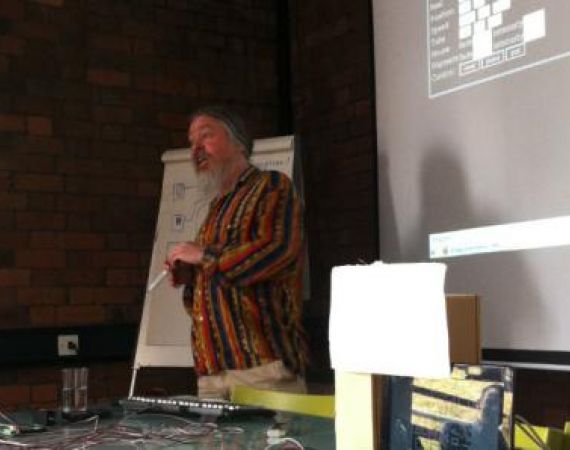Posted on Fri 4 May 2012
Lunchtime Talk: Playful Installations
Tarim has been working with the Pervasive Media Studio since it opened four years ago and has been involved with number of different installation projects and technology platforms that explore embedding playful technology into the world. Tarim describes an installation as a physical thing that…

Tarim has been working with the Pervasive Media Studio since it opened four years ago and has been involved with number of different installation projects and technology platforms that explore embedding playful technology into the world.
Tarim describes an installation as a physical thing that people can look at and engage with, he uses a video example Catch Me Now, which is a project created in collaboration with visual artist Tine Bech to describe installation. Catch Me Now is a unique interactive spotlight, which plays with the audience. A small spotlight light is moving randomly around on its own, until the audience steps into the light, when the light stops and opens up to the user in a play of light via a variety of programmable motion cues, through a wide angled web cam.
What Tarim’s work demonstrates is the diversity of installation art. Installations vary so dramatically from tangible constructions to interactive video art, to immersive virtual realities. They can combine visuals, audio, performance and computer programming, which is where Tarim steps in.
Tarim’s work Musical Stairs is famed amongst the studio residents as it was originally installed in our old Studio space. The project comes into play when someone walks up a staircase, as the person steps on to a stair a sensor would trigger a sound, creating a sequence of sounds or a short sound track. The sounds can be reprogrammed and changed via a web interface, to allow an open platform and a path for people to interact with audiences in a different way. For the talk Tarim hacked our tables to play a programmable set of sounds when anyone wrapped on the tabletops.
What Tarim likes about installation is the cross over of ownership, the moment when the creator hands over the work to the audience. He uses Luke Jerram’s Play Me I’m Yours as an example of this. Every interactive piece reaches a stage where the creator no longer has control of the work and offers it out as ‘yours’.
Tarim’s favourite kinds of Installations are ones that audiences can control. The most accessible way of becoming pilot for such works is through the Internet and mobile phones; Instant Grafitti does exactly that, essentially it is an etch a sketch projected onto a large screen, it allows users (via their mobile devices) to change colour of the cursers to draw on the screen.
Another project in collaboration with Charlotte Crofts is Projection Hero connected to the Curzon cinema in Clevedon. Together Charlotte and Tarim created a miniature cinema which can be controlled by scanning a QR code or putting a web address into a mobile device, the controller can open the curtains, play a film, dim the lights, speed the film up and close the curtains by the touch of a fingertip!
Tarim finishes his talk by introducing the concept of PTTP. He explains that the internet works using a protocol called HTTP: Hyper Text Transfer Protocol, which is a standard way for controlling things on the net. PTTP is a similar thing but is a specific protocol designed for authoring installations and stand for Power To The People. PTTP invites people to write their own interfaces for example, or to interact with and manipulate installations. PTTP presents a standard for people to work from, to start with and become more creative with.
To find out more about these examples or to get involved visit http://www.mediaplaygrounds.co.uk/